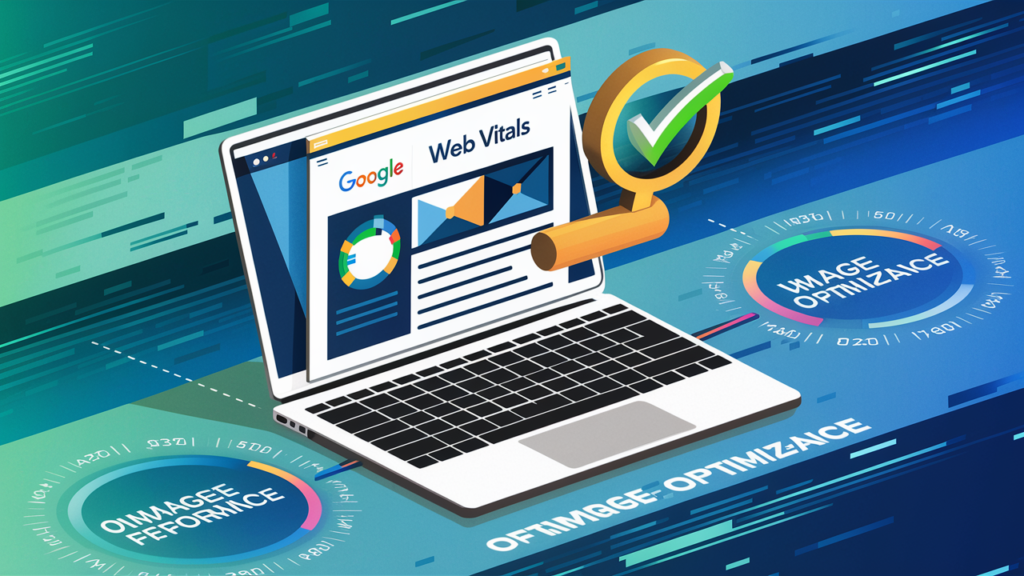In today’s digital landscape, website performance isn’t just about user experience—it’s a critical ranking factor in Google’s algorithm. With the introduction of Core Web Vitals, image optimization has become more crucial than ever. In this comprehensive guide, we’ll explore how proper image optimization can significantly improve your Core Web Vitals scores and boost your website’s search engine rankings.
Understanding Core Web Vitals
Google’s Core Web Vitals consist of three key metrics:
- Largest Contentful Paint (LCP): Measures loading performance
- First Input Delay (FID): Measures interactivity
- Cumulative Layout Shift (CLS): Measures visual stability
Among these, image optimization directly impacts LCP and CLS, making it a crucial factor in your website’s overall performance.
How Images Affect Core Web Vitals
Impact on Largest Contentful Paint (LCP)
LCP measures how long it takes to load the largest content element visible in the viewport. Often, this element is an image. Google recommends an LCP of 2.5 seconds or less for optimal performance.
Common image-related issues that affect LCP:
- Large file sizes
- Unoptimized image formats
- Lack of responsive images
- Poor image compression
Impact on Cumulative Layout Shift (CLS)
CLS measures visual stability by quantifying unexpected layout shifts. Images can significantly contribute to poor CLS scores when:
- Image dimensions aren’t specified
- Images load after the surrounding content
- Responsive images aren’t properly implemented
Best Practices for Image Optimization
1. Choose the Right Image Format
Modern image formats like WebP offer superior compression while maintaining quality. Using our free WebP converter tool, you can easily convert your images to WebP format, reducing file size by up to 30% compared to JPEG or PNG formats.
2. Implement Responsive Images
<picture>
<source srcset="image.webp" type="image/webp">
<source srcset="image.jpg" type="image/jpeg">
<img src="image.jpg" alt="Description" width="800" height="600">
</picture>3. Optimize Image Dimensions
- Serve images at the correct size for each device
- Always specify width and height attributes
- Use aspect ratio boxes to prevent layout shifts
4. Implement Lazy Loading
<img src="image.webp" loading="lazy" alt="Description">5. Use Content Delivery Networks (CDNs)
CDNs can significantly improve image loading times by serving images from servers closer to your users.
Step-by-Step Image Optimization Process
- Audit Your Current Images
- Use tools like Lighthouse to identify image-related issues
- Check current file formats and sizes
- Identify images causing layout shifts
- Convert to WebP Format
- Visit RaikTools WebP Converter
- Upload your images
- Download the optimized WebP versions
- Implement with proper fallbacks for older browsers
- Implement Proper Image Loading
- Add width and height attributes
- Implement lazy loading for below-the-fold images
- Use responsive image techniques
- Monitor Performance
- Regular Core Web Vitals checks
- Track image loading times
- Monitor user experience metrics
Advanced Optimization Techniques
1. Automated Image Optimization
Implement automated tools in your development pipeline for consistent optimization:
- Build-time optimization
- Server-side optimization
- CDN-based optimization
2. Next-Gen Image Formats
Consider implementing multiple formats for optimal browser support:
- WebP as primary format (using our converter tool)
- AVIF for supporting browsers
- JPEG/PNG as fallbacks
3. Art Direction
Use different image crops for different screen sizes:
<picture>
<source media="(min-width: 800px)" srcset="hero.webp">
<source media="(min-width: 400px)" srcset="hero-mobile.webp">
<img src="hero-fallback.jpg" alt="Hero image">
</picture>Measuring Success
Key Metrics to Track
- Core Web Vitals scores
- LCP improvements
- CLS reductions
- Overall performance score
- User Experience Metrics
- Page load time
- Bounce rate
- User engagement
- SEO Impact
- Search rankings
- Organic traffic
- Mobile search performance
Common Pitfalls to Avoid
- Over-compression leading to quality loss
- Ignoring mobile optimization
- Not providing fallback formats
- Neglecting alt text and accessibility
- Improper image dimensioning
Tools and Resources
- Image Optimization Tools
- RaikTools WebP Converter – Our free tool for WebP conversion
- Google Lighthouse
- PageSpeed Insights
- Performance Monitoring
- Google Search Console
- Chrome User Experience Report
- Web Vitals Extension
Conclusion
Image optimization is no longer optional for websites aiming to rank well in search results. With Core Web Vitals being a crucial ranking factor, proper image optimization can give your website a significant competitive advantage.
Start optimizing your images today using our free WebP converter and see the immediate impact on your Core Web Vitals scores. Remember, better performance leads to better user experience, which ultimately results in better search rankings and increased conversions.
FAQs
Q: How much can WebP format improve my image sizes? A: WebP can reduce image sizes by 25-35% compared to JPEG/PNG while maintaining similar quality.
Q: Will image optimization immediately improve my Core Web Vitals? A: Yes, proper image optimization can lead to immediate improvements in LCP and CLS scores.
Q: How often should I check my Core Web Vitals scores? A: Monthly monitoring is recommended, with immediate checks after major website updates.






